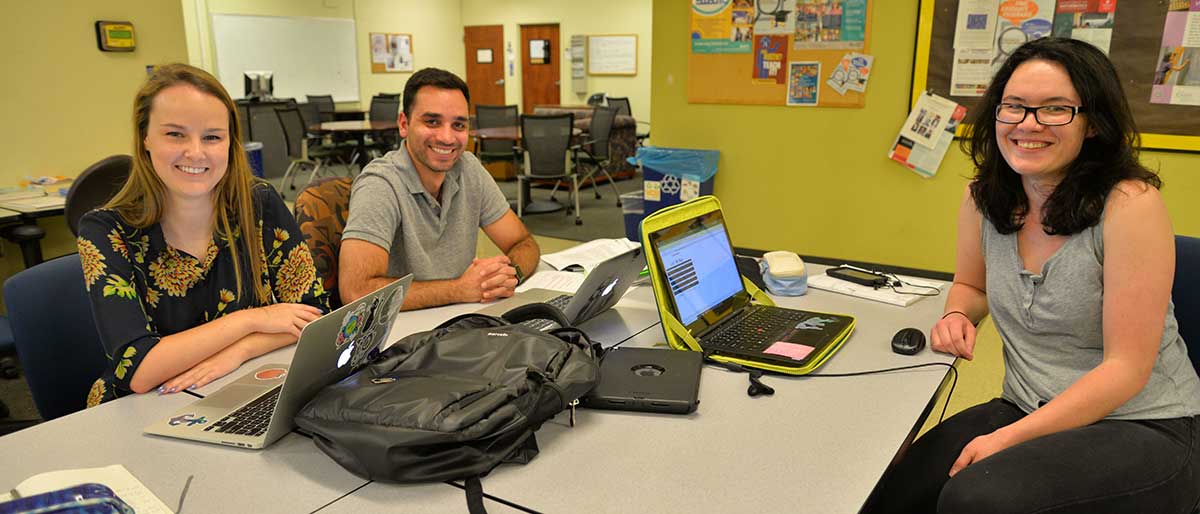VCU students’ internship will help VDOT better predict oversight costs of local projects
August 27, 2019

A team of four Virginia Commonwealth University graduate students is developing a predictive model for VDOT that will help the agency more accurately estimate oversight costs for local transportation projects.
The students — Jessica Cooper, Katrina Gauntt, Dani Jabado and Katherine Werner — are interning with the Virginia Department of Transportation’s Local Assistance Division to build a predictive modeling tool for oversight costs of locally administered projects. In those, a local government is responsible for project development and delivery but with oversight by VDOT to ensure that applicable laws and regulations are met.
Locally administered projects represent roughly half of all statewide transportation projects and account for nearly a quarter of total statewide transportation project funding.
“The problem, as it was described to us, was that when you underestimate oversight costs, it’s bad for the localities because the locality then needs to come up with more money and they weren’t ready for it,” Cooper said.
Similarly, if oversight cost is overestimated, it unnecessarily ties up funding that could have been used elsewhere. “So the goal of this project is to help VDOT estimate those costs as accurately as possible,” she said.
Cooper, Werner and Gauntt are master’s degree students in the Department of Statistical Sciences and Operations Research in the College of Humanities and Sciences. Jabado is pursuing a master’s degree in information systems in the School of Business.
Lloyd B. Arnold, manager of the locally administered projects program of VDOT’s Local Assistance Division, said the students’ work would address a major business challenge for the agency.
“Transportation projects have very tight budgets and where oversight costs can be accurately forecasted, our local partners are better able to financially plan, budget and gain acceptance of their initiatives,” Arnold said. “Predictive modeling should help VDOT better understand the number of factors, the magnitude of each factor, and other variables that influence oversight cost.”
"What we hope to do is [create] a page where you can plug in key drivers: Is it federally eligible? Type of project? How long do you think it’ll take? … And then the model will pop out how much it’s estimated to cost for oversight."
—Jessica Cooper
SSOR master's program student
The students have been working with a data set of more than 700 locally administered projects from 2013 to 2019. Using at least seven variables — such as estimated cost, completion time and actual costs — the idea is that the model will rely on historic data to better predict future costs.
“What we hope to do is [create] a page where you can plug in key drivers: Is it federally eligible? Type of project? How long do you think it’ll take? Things like that, including a few other drivers. And then the model will pop out how much it’s estimated to cost for oversight,” Cooper said. “It won’t provide the final project estimate — [VDOT officials] will still decide that using other construction estimating tools — but this would be a first step in providing administrative oversight costs.”
Joe Grubbs, Ph.D., who works in VDOT's Information Technology Division and is an adjunct professor in VCU's School of Business, helped facilitate the partnership between VCU and VDOT. Julie Brown, director of VDOT’s Local Assistance Division, also played a key role, seeing the project as an opportunity for the students to gain experience while also supporting the VDOT Business Plan.
Rebecca Durfee, teaching assistant professor and assistant chair in the Department of Statistical Sciences and Operations Research, said the students are getting valuable real-world experience with this project.
“The students are weeding through the data they've been given, determining what is important, creating a model based on that data and will report their findings to a real client who will actually use their model in practice,” she said. “They will be able to go out into the workforce with much more confidence, knowing that they already have their first real experience under their belts.”
The team is conducting an exploratory analysis of the data to decide what should and should not be included in the final model.
“We’re trying to decide which variables would be the most important to look at,” said Werner, who graduated from VCU in 2017 with a degree in psychology.
The project is also providing real-world experience in that it involves an interdisciplinary team, with grad students in statistics and business. Jabado, who graduated from VCU in 2016, majoring in forensic science and biology, is handling the project’s information systems needs.
“Basically I’ve been getting my feet wet in the data science field and learning new software like [business analytics tool] Power BI and helping to implement it in a real-world situation,” he said.
One of the team’s biggest challenges so far? Learning how to “speak VDOT,” meaning how to navigate the agency’s technical jargon where, for example, “PE” could refer to either “project estimate” or “preliminary engineering.”
“So many acronyms,” Cooper said. “We had to make a glossary.”
By Brian McNeill
University Public Affairs
804-827-0889
bwmcneill@vcu.edu